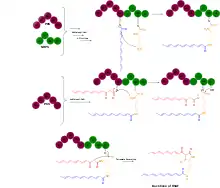.svg.png.webp) | |
| Names | |
|---|---|
| IUPAC name
(3E,5S,7S,8R,9S,10S,11S,13R,15R,16S,18Z)-11-Ethyl-7,24,28-trihydroxy-10-methyl-21,26-diazapentacyclo[23.2.1.05,16.08,15.09,13]octacosa-1(28),3,18-triene-2,20,27-trione | |
| Systematic IUPAC name
(3E,5S,7S,8R,9S,13R,15R,16S)-11-Ethyl-7,28-dihydroxy-8,10-dimethyl-21,26-diazapentacyclo[23.2.1.05,16.08,15.09,13]octacosa-1(28),3-diene-2,27-dione | |
| Other names
Heat-Stable Anti-fungal Factor (HSAF) | |
| Identifiers | |
3D model (JSmol) |
|
| ChemSpider | |
PubChem CID |
|
| |
| |
| Properties | |
| C29H40N2O6 | |
| Molar mass | 512.647 g·mol−1 |
Except where otherwise noted, data are given for materials in their standard state (at 25 °C [77 °F], 100 kPa).
Infobox references | |
Dihydromaltophilin, or heat stable anti-fungal factor (HSAF), is a secondary metabolite of Streptomyces sp. and Lysobacter enzymogenes.[1][2][3] HSAF is a polycyclic tetramate lactam containing a single tetramic acid unit and a 5,5,6-tricyclic system. HSAF has been shown to have anti-fungal activity mediated through the disruption of the biosynthesis of Sphingolipid's by targeting a ceramide synthase unique to fungi.[4][5]
Biosynthesis
The backbone of HSAF is formed through a hybrid PKS-NRPS cluster containing one nonribosomal peptide synthase (NRPS) module and one polyketide synthase (PKS) module.[2][6][7][8] The single PKS module functions in a non-canonical fashion in that it is an iterative type I PKS responsible for the generation of the two unique polyketides needed in the backbone of HSAF using malonyl-CoA as both the starter and extender unit, while the NRPS module is responsible for the linking of the polyketides to an L-ornithine unit and the initial cyclization to create the tetramate back bone.[2][7][8] The coding region related to HSAF production contains a PKS-NRPS with a total of 9 domains, (KS-AT-DH-KR-ACP-C-A-PCP-TE), while a cascade of FAD-dependent redox reactions (OX1-OX4) flank the PKS-NRPS cluster proposed to be responsible for formation of the 5,5,6-tricyclic system, there are additional coding regions for a putative regulator, an arginase for L-ornithine production from Arginine, and a transporter which flank the PKS-NRPS.[2][3][7][8]


References
- ↑ Graupner, P. R.; Thornburgh, S.; Mathieson, J. T.; Chapin, E. L.; Kemmitt, G. M.; Brown, J. M.; Snipes, C. E. (1997). "Dihydromaltophilin; a novel fungicidal tetramic acid containing metabolite from Streptomyces sp". The Journal of Antibiotics. 50 (12): 1014–1019. doi:10.7164/antibiotics.50.1014. ISSN 0021-8820. PMID 9510907.
- 1 2 3 4 Xie, Yunxuan; Wright, Stephen; Shen, Yuemao; Du, Liangcheng (2012). "Bioactive natural products from Lysobacter". Natural Product Reports. 29 (11): 1277–1287. doi:10.1039/c2np20064c. ISSN 1460-4752. PMC 3468324. PMID 22898908.
- 1 2 Lou, Lili; Qian, Guoliang; Xie, Yunxuan; Hang, Jiliang; Chen, Haotong; Zaleta-Rivera, Kathia; Li, Yaoyao; Shen, Yuemao; Dussault, Patrick H. (2011-02-02). "Biosynthesis of HSAF, a tetramic acid-containing macrolactam from Lysobacter enzymogenes". Journal of the American Chemical Society. 133 (4): 643–645. doi:10.1021/ja105732c. ISSN 1520-5126. PMC 3078565. PMID 21171605.
- ↑ Li, Shaojie; Du, Liangcheng; Yuen, Gary; Harris, Steven D. (2006). "Distinct Ceramide Synthases Regulate Polarized Growth in the Filamentous Fungus Aspergillus nidulans". Molecular Biology of the Cell. 17 (3): 1218–1227. doi:10.1091/mbc.E05-06-0533. ISSN 1059-1524. PMC 1382311. PMID 16394102.
- ↑ Li, Shaojie; Calvo, Ana M.; Yuen, Gary Y.; Du, Liangcheng; Harris, Steven D. (2009). "Induction of cell wall thickening by the antifungal compound dihydromaltophilin disrupts fungal growth and is mediated by sphingolipid biosynthesis". The Journal of Eukaryotic Microbiology. 56 (2): 182–187. doi:10.1111/j.1550-7408.2008.00384.x. ISSN 1550-7408. PMID 21462551. S2CID 33464609.
- ↑ Yu, Fengan; Zaleta-Rivera, Kathia; Zhu, Xiangcheng; Huffman, Justin; Millet, Jeffrey C.; Harris, Steven D.; Yuen, Gary; Li, Xing-Cong; Du, Liangcheng (2007-01-01). "Structure and Biosynthesis of Heat-Stable Antifungal Factor (HSAF), a Broad-Spectrum Antimycotic with a Novel Mode of Action". Antimicrobial Agents and Chemotherapy. 51 (1): 64–72. doi:10.1128/AAC.00931-06. ISSN 0066-4804. PMC 1797680. PMID 17074795.
- 1 2 3 Li, Yaoyao; Chen, Haotong; Ding, Yanjiao; Xie, Yunxuan; Wang, Haoxin; Cerny, Ronald L.; Shen, Yuemao; Du, Liangcheng (2014-07-14). "Iterative assembly of two separate polyketide chains by the same single-module bacterial polyketide synthase in the biosynthesis of HSAF". Angewandte Chemie International Edition. 53 (29): 7524–7530. doi:10.1002/anie.201403500. ISSN 1521-3773. PMC 4107061. PMID 24890524.
- 1 2 3 Chen, Haotong; Du, Liangcheng (2014). "Iterative polyketide biosynthesis by modular polyketide synthases in bacteria". Applied Microbiology and Biotechnology. 100 (2): 541–557. doi:10.1007/s00253-015-7093-0. ISSN 1432-0614. PMC 4706475. PMID 26549236.